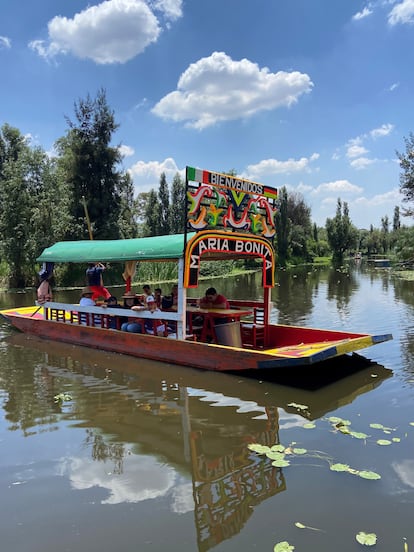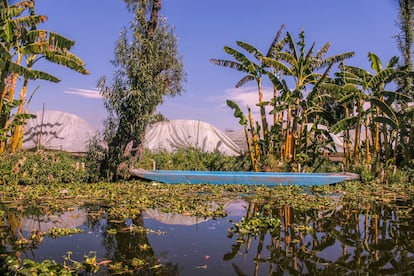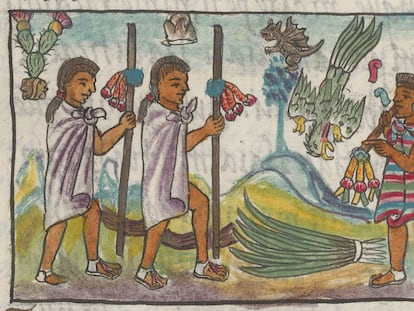Xochimilco, the magical lake where tourism, sustainability and folklore come together
Known for its colorful gondolas, the nature reserve south of Mexico City is home to an endemic amphibian called the ‘axolotl’

Lake Xochimilco, located south of Mexico City, is known for its famous trajineras — gondola-like boats that navigate the canals extending beyond the lake. Each boat is uniquely named (Amor de los dos, Viva Amelia...) and adorned with vibrant, folkloric designs. Families, friends, students and mariachi bands all gather here for festive weekend parties. At the Cuemanco pier, I board a trajinera with Rosalba del Valle, a member of the Olintlalli cooperative. The gondolier pushes away from the pier and away we go from the bustling lakeshore to discover the hidden side of Xochimilco.
From a far-off trajinera we can hear the wails of a Joan Sebastian song and tequila toasts. “Xochimilco is famous for this festive atmosphere, but it’s also important for other reasons,” said Del Valle as we navigate the silence of this dense nature preserve. The impressive chinampas are artificial islands, a technique used in Mesoamerican agriculture to grow crops on the shallow lake beds in the Valley of Mexico. They were made centuries ago out of intertwined reeds and mud so crop roots could extend down into the water. “These artificial islands were actually created to provide food for the Aztec empire. The trees on these islands are hollow, but their roots are quite sturdy and help support the chinampas without blocking the sunlight.”

Xochimilco is a combination of the Nahuatl words xochitl and milli and means “where the flowers grow.” Traditional growing techniques preserve the teachings of pre-Hispanic agriculture and botany. UNESCO recognizes 18,600 acres (7,534 hectares) of chinampas in Xochimilco, Milpa Alta and Tláhuac as natural world heritage sites. Some chinampas still practice agroecology, using biofertilizers instead of agrochemicals and biofilters to purify water. The result? Some of the most exceptional vegetables and flowers available in Mexico City.
“The whole concept of this agrotourism cooperative started because we wanted to save the axolotl species, a salamander-like amphibian that is only found in Xochimilco,” said Del Valle. “We’re all about preserving this way of life. We plant small crop beds and sell our flowers to buyers from Jamaica. Our products also go to alternative outlets and directly to consumers. Top-notch restaurants like Chantico, Tetetlan and Antolina Condesa also buy our seasonal products.”
The chinampas demonstrate ancient sowing techniques using grids (chapines), and agricultural methods to manage mud, transplant seedlings by hand, and protect crops like radishes, cabbages, purple carrots, black tomatoes, rutabagas, broccoli, kale, and pumpkins. Rosalba’s brother Javier offers us a taste of tarragon flower, an herb often used in salads that has a sweet anise flavor with a hint of spiciness.
Javier tells us more about the axolotl, an unusual water-dwelling creature with an extraordinary ability to regenerate limbs, organs and tissues. It also inspired the blue Pokémon Wooper and Toothless from the How to Train Your Dragon movie. “To save the species, the first step is to save its habitat. This pool of clean water we call a ‘foxtail’ is where it lays its eggs, because there are tiny organisms there that help it find food. These organisms are an aquatic predator, and their favorite snack is the acocil, a type of water worm.” We look for some axolotls, but no luck. Rosalba shows us a photo on her phone of one they rescued a week earlier. The eight-inch pink creature looks cartoonish, like it couldn’t be real. After a meal of pozole soup, chicken and cucumbers — washed down with mint-flavored water — it’s time to leave the chinampa. We climb into the trajinera, thinking about what Octavio Paz once said: “To be truly modern, we must first embrace tradition.” In parting, Javier doesn’t say goodbye, only “farewell.”
Sign up for our weekly newsletter to get more English-language news coverage from EL PAÍS USA Edition










































